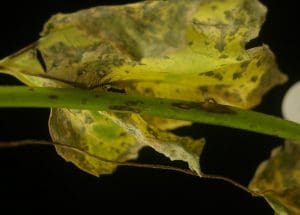
CottonInfo regional extension officer, Janelle Montgomery, collects Noogoora burr samples in the Gwydir catchment.
RESEARCH into development of a potential bio-herbicide for the invasive weed Noogoora burr has been welcomed by the wool industry.
The New South Wales Department of Primary Industries has said a naturally-occurring fungus is being harnessed to tackle Noogoora burr, an invasive weed which causes major impacts on agriculture and the environment in eastern Australia.
NSW Department of Primary Industries (DPI) research agronomist, Graham Charles, said the project has identified a fungal pathogen, Alternaria zinniae, as a potential bio-herbicide.
“Glasshouse trials have found the fungus will infect Noogoora burr, but it requires an extended period of dew or surface moisture for maximum impact.
“In collaboration with Melbourne University, we are developing complex emulsion formulations of fungal spores, which retain moisture to enhance infection of the weeds over time,” Mr Charles said.
Noogoora burr is a wool processing problem
Dubbo-based wool broker Cameron Coggan welcomed the research and said Noogoora burr was recognised as one of the worst burrs in regards to wool processing, because it did not comb out and had to be carbonised, discounting the value of raw wool containing burr.
“With Nooroora burr, its spikes don’t off, so it stays in the wool and represents a real problem in terms of getting it out of wool.”
Dubbo wool broker, grower and AWI director Don Macdonald said Noogoora burr normally growers around creeks and river banks.
“It’s got to have its feet wet.
“The carbonisers would love it, if you got rid of Noogoora burr.”
Noogoora burr is also poisonous to stock at the seedling stage and the dry burrs can also cause discomfort and injury to sheep.

A Noogoora burr plant infected with the fungal pathogen, Alternaria zinnia. Image – NSW DPI.
Mr Charles said Noogoora burr poses a unique conundrum due to its many species and complex DNA and researchers needed to ensure the fungus is effective across all species.
“DNA sequencing is helping clarify differences between four species within what is called the Noogoora burr complex, Noogoora burr Xanthium occidentale, Hunter burr X. italicum, Californian burr X. orientale, South American burr X. cavanillesii and interspecific hybrids.”
Noogoora burr samples collected in NSW and Queensland

A Noogoora burr plant showing flowers and seeds. Image – Agriculture Victoria.
To date, about 100 Noogoora burr samples have been collected from New South Wales and Queensland.
In preliminary DNA barcoding and population genetics work, NSW DPI and the University of Queensland found Hunter burr and Noogoora burr are genetically different, but hybrids of both exist. This information will be useful in understanding any future species-specific responses to the new bio-herbicide.
NSW DPI said Noogoora burr also hosted pest insect species and fungal pathogens which affected cotton, including environmental pests and Verticillium dahliae which causes Verticillium wilt – a major concern for the cotton industry. NSW DPI cotton pathologists are using molecular techniques to determine what strain of V. dahliae is hosted by each of the species in the Noogoora burr complex.
In Australia there are three strains of V. dahliae in cotton and it is important to identify alternative hosts of each strain. Preliminary DNA results indicated individual burrs can host more than one strain of this pathogen.
NSW DPI is leading the two-year Noogoora burr project, funded by the federal Department of Agriculture and Water Resources, in partnership with the Cotton Research Development Corporation, Murrumbidgee Irrigation and the University of Queensland to develop a bio-herbicide to manage the weed.
The Noogoora burr project started in 2017 and will run until 2019 under the Australian Government’s Control tools and technology for established pests, animals and weeds competitive grants program.
Source: NSW DPI.

HAVE YOUR SAY